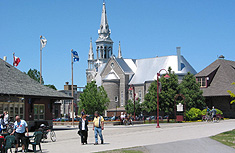SAINT-JÉRÔME, “CAPITAL OF THE LAURENTIANS”
 Located at the edge of the lower Laurentians on the picturesque Rivière du Nord, Saint-Jérôme is often called the “Capital of the Laurentians”. With a population of 60,000, including the surrounding sectors of Bellefeuille, Lafontaine, and Saint-Antoine, the town is an important regional administrative and service centre, with a strong retail and industrial base.
Located at the edge of the lower Laurentians on the picturesque Rivière du Nord, Saint-Jérôme is often called the “Capital of the Laurentians”. With a population of 60,000, including the surrounding sectors of Bellefeuille, Lafontaine, and Saint-Antoine, the town is an important regional administrative and service centre, with a strong retail and industrial base.

 Sise à la bordure septentrionale des îles de Montréal et de Laval, la région des Laurentides se compose de deux entités géographiques à la morphologie opposée, au sud la plaine, au nord les collines, soudées dans un destin commun par l'histoire. Des chasseurs-cueilleurs en foulaient le sol il y a au moins 9 000 ans.
Sise à la bordure septentrionale des îles de Montréal et de Laval, la région des Laurentides se compose de deux entités géographiques à la morphologie opposée, au sud la plaine, au nord les collines, soudées dans un destin commun par l'histoire. Des chasseurs-cueilleurs en foulaient le sol il y a au moins 9 000 ans.